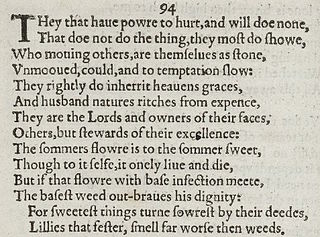In poetry, metre or meter is the basic rhythmic structure of a verse or lines in verse. Many traditional verse forms prescribe a specific verse metre, or a certain set of metres alternating in a particular order. The study and the actual use of metres and forms of versification are both known as prosody.

Poetry is a form of literary art that uses aesthetic and often rhythmic qualities of language to evoke meanings in addition to, or in place of, literal or surface-level meanings. Any particular instance of poetry is called a poem and is written by a poet. Poets use a variety of techniques called poetic devices, such as assonance, alliteration, euphony and cacophony, onomatopoeia, rhythm, and sound symbolism, to produce musical or incantatory effects. Most poems are formatted in verse: a series or stack of lines on a page, which follow a rhythmic or other deliberate pattern. For this reason, verse has also become a synonym for poetry.

The term sonnet derives from the Italian word sonetto. It refers to a fixed verse poetic form, traditionally consisting of fourteen lines adhering to a set rhyming scheme. Originating in 13th-century Sicily, the sonnet was in time taken up in many European-language areas, mainly to express romantic love at first, although eventually any subject was considered acceptable. Many formal variations were also introduced, including abandonment of the quatorzain limit – and even of rhyme altogether in modern times.
A tercet is composed of three lines of poetry, forming a stanza or a complete poem.
French poetry is a category of French literature. It may include Francophone poetry composed outside France and poetry written in other languages of France.
SciFaiku is a form of science fiction poetry first announced by Tom Brinck with his treatise on the subject, The SciFaiku Manifesto. Brinck has been referred to as the "Father of SciFaiku." SciFaiku is inspired by Japanese haiku, but explores science, science fiction (SF), and other speculative fiction themes, such as fantasy and horror. They are based on the principles and form of haiku but can deviate from its structure.

This glossary of literary terms is a list of definitions of terms and concepts used in the discussion, classification, analysis, and criticism of all types of literature, such as poetry, novels, and picture books, as well as of grammar, syntax, and language techniques. For a more complete glossary of terms relating to poetry in particular, see Glossary of poetry terms.
This is a glossary of poetry terms.

Sonnet 94 is one of 154 sonnets written by the English playwright and poet William Shakespeare. It is a member of the Fair Youth sequence, in which the poet expresses his love towards a young man.

Sonnet 153 is a sonnet by William Shakespeare.

Sonnet 10 is one of 154 sonnets written by the English playwright and poet William Shakespeare. It is a procreation sonnet within the Fair Youth sequence.
Sonnet 17 is one of 154 sonnets written by the English playwright and poet William Shakespeare. It is the final poem of what are referred to by scholars as the procreation sonnets with which the Fair Youth sequence opens.

Sonnet 31 is one of 154 sonnets written by the English playwright and poet William Shakespeare. It is a sonnet within the Fair Youth sequence. Developing an idea introduced at the end of Sonnet 30, this poem figures the young man's superiority in terms of the possession of all the love the speaker has ever experienced.
The following outline is provided as an overview of and introduction to poetry:
The volta is a rhetorical shift or dramatic change in thought and/or emotion. Turns are seen in all types of written poetry. In the last two decades, the volta has become conventionally used as a word for this, stemming supposedly from technique specific mostly to sonnets. Volta is not, in fact, a term used by many earlier critics when they address the idea of a turn in a poem, and they usually are not discussing the sonnet form. It is a common Italian word more often used of the idea of a time or an occasion than a turnabout or swerve.

Sonnet 151 is the 151st of 154 poems in sonnet form by William Shakespeare published in a 1609 collection titled Shakespeare's sonnets. The sonnet belongs to the Dark Lady sequence, which distinguishes itself from The Fair Youth sequence by being more overtly sexual in its passion. Sonnet 151 is characterized as "bawdy" and is used to illustrate the difference between the spiritual love for the Fair Youth and the sexual love for the Dark Lady. The distinction is commonly made in the introduction to modern editions of the sonnets in order to avoid suggesting that Shakespeare was homosexual.

Sonnet 75 is one of 154 sonnets written by the English playwright and poet William Shakespeare. It is a member of the Fair Youth sequence, in which the poet expresses his love towards a young man.

Sonnet 106 is one of 154 sonnets written by the English playwright and poet William Shakespeare. It is a member of the Fair Youth sequence, in which the poet expresses his love towards a young man.
Pilish is a style of constrained writing in which the lengths of consecutive words or sentences match the digits of the number π (pi). The shortest example is any three-letter word, such as "hat", but many longer examples have been constructed, including sentences, poems, and stories.
Poetic devices are a form of literary device used in poetry. Poems are created out of poetic devices via a composite of: structural, grammatical, rhythmic, metrical, verbal, and visual elements. They are essential tools that a poet uses to create rhythm, enhance a poem's meaning, or intensify a mood or feeling.